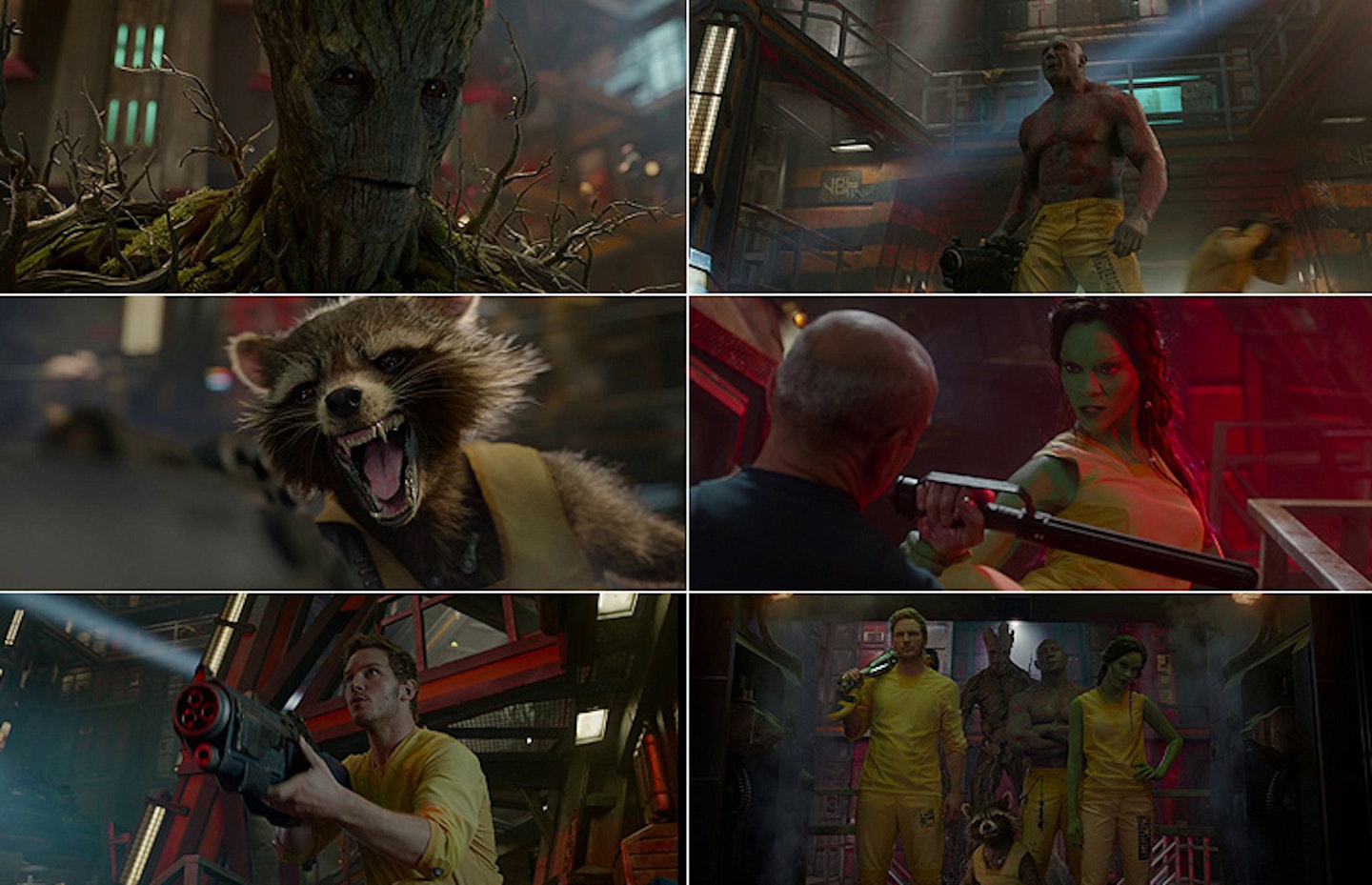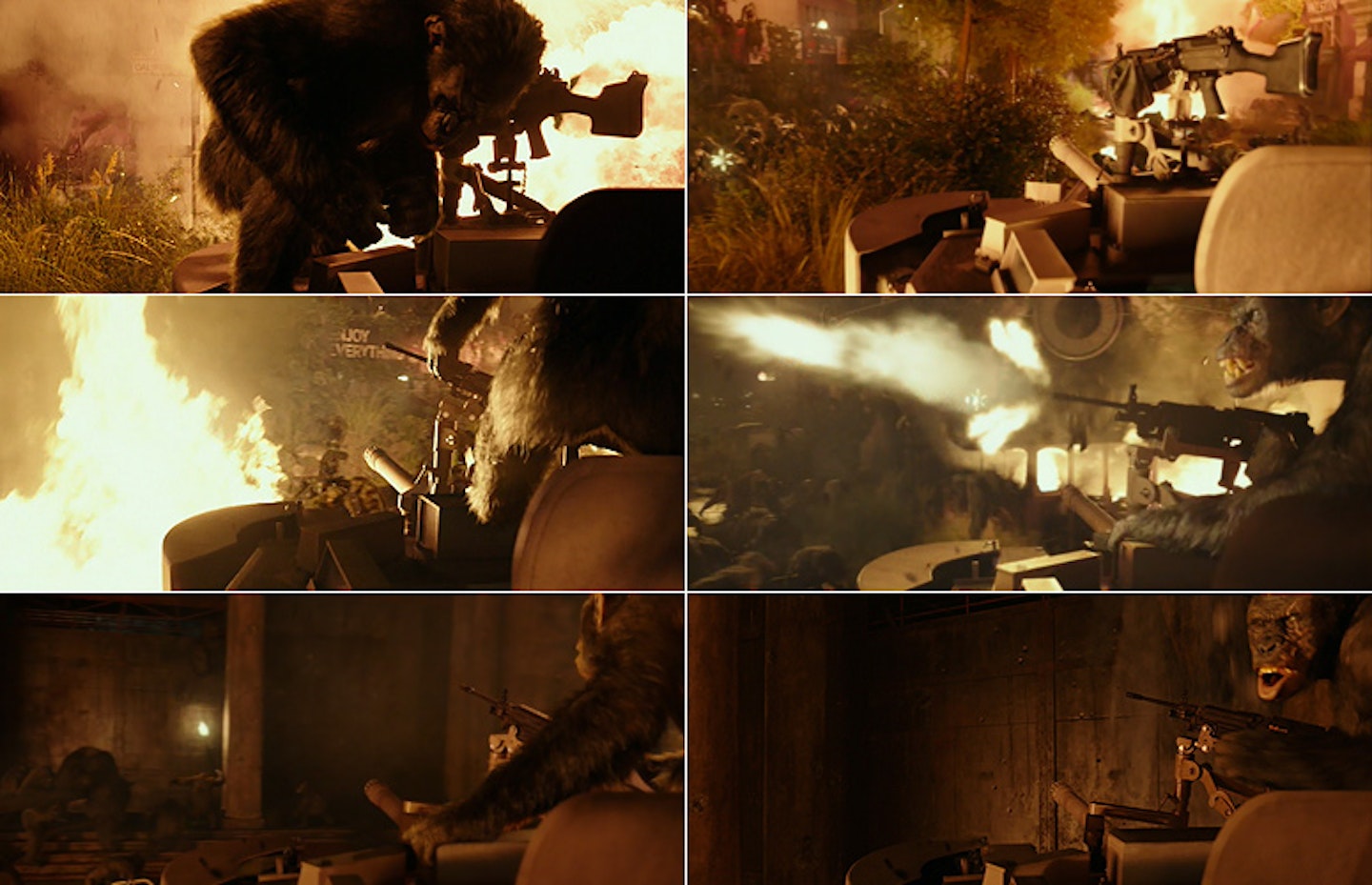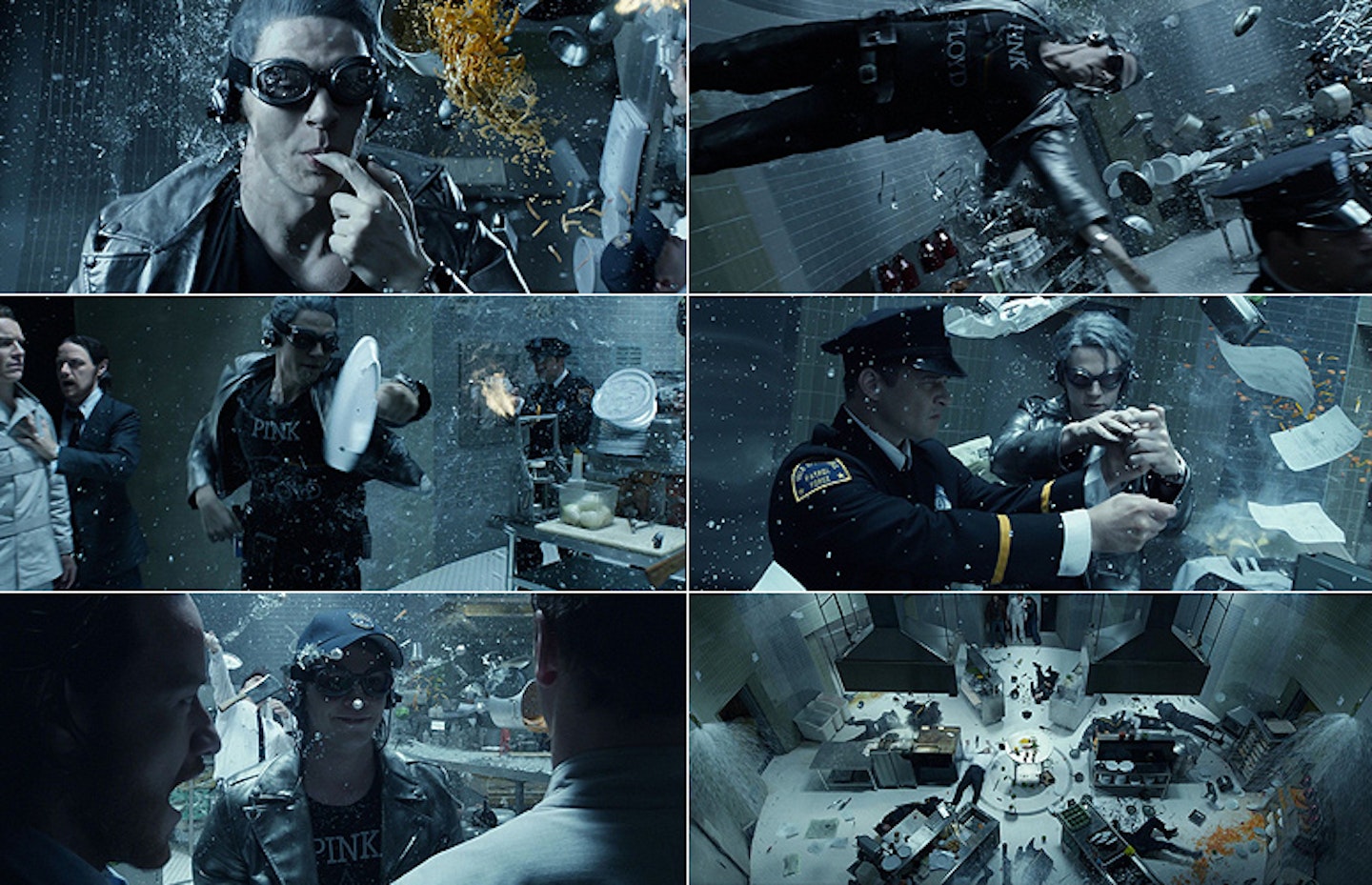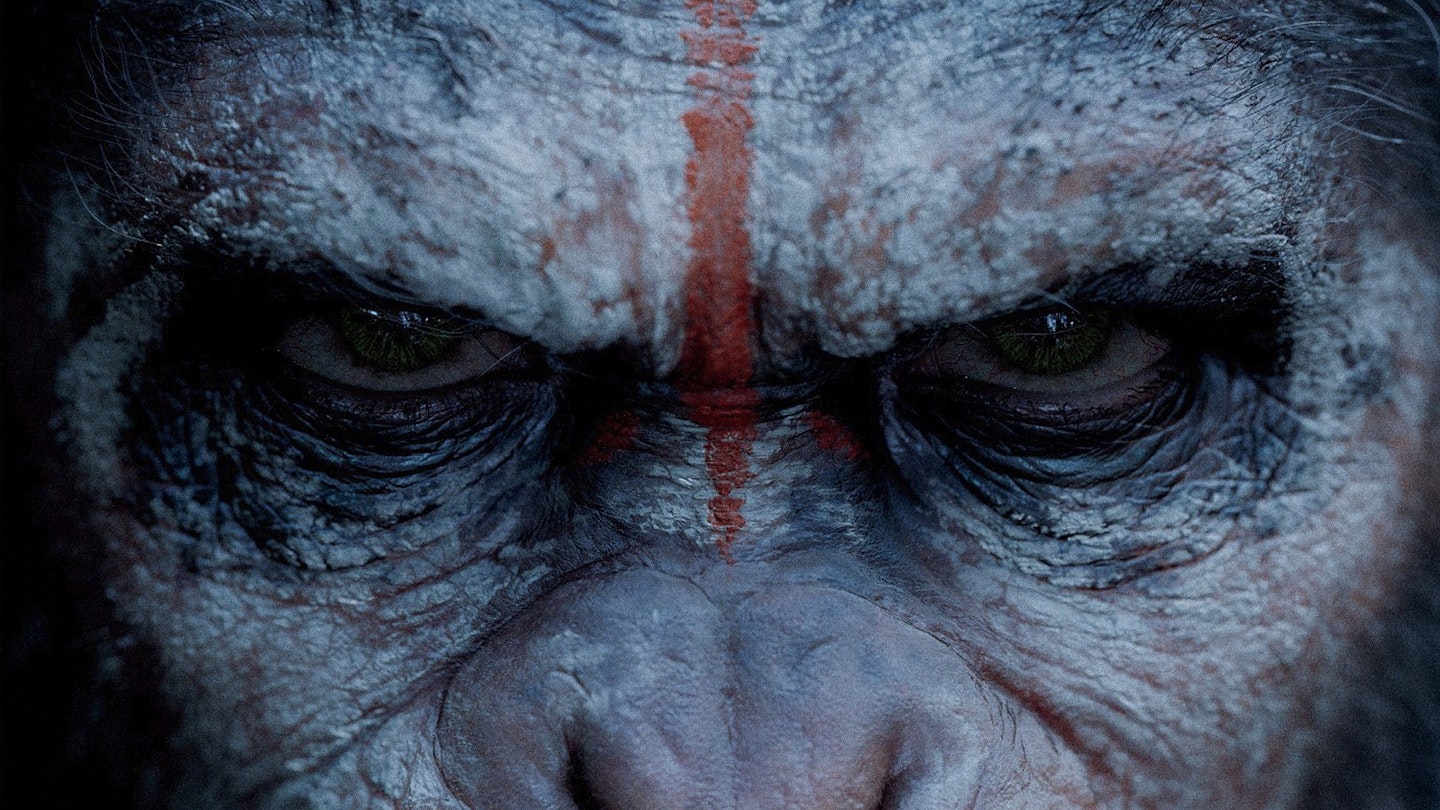The number of candidates for Scene of the Year is long and illustrious. Some have popped up the Jokes, Deaths and [Cameos Of The Year](http://www.empireonline.com/features/best-movie-cameos-2014/os-2014/ section) (our equivalent of births, deaths and marriages), a number warrant special mentions – the beach scene in Under The Skin, the vodka-soaked argument in Leviathan and Imelda Staunton waving a dildo about in Pride, to name but three – but after much debate and discussion we’ve plumped for three action sequences that showcase the cutting edge of effects work married to directorial flair and good, old-fashioned creative chutzpah. We loved them and we hope you did too...
1. Guardians Of The Galaxy's prison break

The director of everyone’s favourite Marvel space opera spoke to Empire for our Guardians Of The Galaxy spoiler special podcast, where the film’s stand-out scene – where Rocket busts the gang out of the interplanetary penitentiary known as the Kyln – was discussed, but not in the fine detail it deserved. As it’s now out on Blu-ray, and there’s a whole Review Of The Year thing going on, we spoke to James Gunn again about how he made unleashed the anarchy.
Some of this sequence was shown at Comic-Con in 2013, days after you started shooting. How did you pull that off?
That was simply luck. The first thing we shot was the mug shot sequence because I knew that was probably something we might want to use for Comic-Con, for an early trailer. Then we shot a couple of days on the exterior of Morag – the planet where The Orb is found by Star-Lord. Then we shot in the Kyln, so we had 11 days of shooting under our belts when we came to Comic-Con, and the Disney guys were great at putting the footage together for a trailer.
Was the Kyln one of the first sets your art team put together?
We were putting together all of the sets simultaneously, because they were all such huge sets, but yep, the Kyln was one of the huge sets we put together at first. It was very difficult, actually. I think it was about 300 pounds of steel, so it was incredibly huge. The hardest part was deciding on the size of the Kyln, because originally I wanted it to be a little bigger, but we simply couldn’t afford that, so I had to decide whether to build half of the Kyln and figure out shooting everything from backwards angles, or whether I wanted to build a whole, smaller Kyln. I really didn’t want to build half because we’d had to do that already with the mall fight sequence – that was only one level that we doubled up – and here I had to figure out how to shoot that action over one level, from down below to up above, and it was a real pain in the ass to figure that out.
Did it actually feel like a prison?
Oh yeah, it felt like a prison. I mean, we had all the cells all over but only some of were workable full cells. Some of them were stage cells: the doorway was there, but a couple of feet behind the door there was a fake wall. But the big cells were all real so when you walked on to that set, it felt like an actual prison, with the exception of looking up, because when you looked up and there was nothing there.
How much did the final tiny, hidden spaceship live up to your initial idea of how it would look?
I think it was very, very similar to how I initially imagined it. When I first wrote the prison break, I actually storyboarded that little sequence as I was writing, and the watchtower that I drew looks a lot like the watchtower in the film. I’m not going to show my “art” to the world because my drawings are so awful. Honestly, when they look really good, they look like Playmobile people, and when they’re bad they look like squiggly lines, but I understand them, which is the most important part.
Were there improvised moments that you loved but didn’t make the final cut?
There were some really good moments in there, but you have to take into account what are the really best moments that *really *work. The truth is, we cut a lot of different versions of the one-legged prisoner/Quill exchange and put them in that scene and the one that was the funniest was that simple one – that seemed to work the best and get the point across that there was a big huge explosion. All this crazy stuff happening, then this small thing, and we found that that was simply the funniest version of it.
When Groot sets off the alarm, an unlucky prisoner gets thumped on the head. Who is he? He does great work.
(Laughs) He was a stunt man. I agree, he was great. We did that shot a lot of times, and it was rough, a long take. My brother Sean was doing Rocket, and we had to get that moment right. Then Zoe and Quill had to do all their things right so it was a pretty difficult long take.
When Groot is screaming and Rocket’s on his shoulder, blasting his gun, how was that shot?
Well, you’re pointing your camera at nothing to begin with (laughs). That specific situation was different because we were so high up in the air that we couldn’t do our reference of putting Stuffy in there – ‘Stuffy’ is our stuffed reference Rocket, by the way – but we didn’t do a reference on this occasion because it was too high in the air.
In the prison break scene, we see that Groot can stretch himself bigger. What is the limit to his power?
Well, he can’t do smaller, he can only do bigger, because he does bigger and then he breaks off. And he’s not as strong as Drax, as Groot shows his weakness with Drax – Drax is so strong he can tear through wood. Remember this, guys: Groot’s bark isn’t invincible.
2. Dawn Of The Planet Of The Apes' tank attack

In a home run of an action sequence, Koba (Toby Kebbell) leads a charge on the human stragglers’ San Francisco bastion, commandeering a Bradley Fighting Vehicle and letting rip with its heavy weaponry. In a film played largely in a minor key it’s a staggeringly symphonic moment, with Matt Reeves and his Weta Digital collaborators executing a breathtaking POV tracking shot aboard a charging slab of steel and bullets. Reeves talked us through its design and execution.
“It was a conceptual idea that I wanted to do. Kind of the same thing as what we did in Let Me In with the car crash — it struck the same emotion in me. It has that same kind of eerie control, despite being a chaotic moment. Almost like that tone you get from Children Of Men, where it’s not like it’s really a guy who’s operating a camera in the circumstances, because if it were, the guy would be ducking and bobbing and hiding. Instead it’s like this camera that’s in the midst of it all, but somehow indifferent to the action. And that creates a very disturbing kind of feeling. Well, it does for me, anyway!
“The execution of it was much more involved than you may think. Actually, the easiest part of it was getting the shot, because there was nothing on the set except for the tank, so it was just Koba on the tank, with someone down below driving it and the turret was turning, and then it ended by crashing into the doors. The weird thing was, we had one take to get it right and they actually didn’t hit the doors! (laughs). So I told Weta that I hoped they could fix it! And they did. But we then had to stage the events on the tank and all the stuff around it and we shot all of that in the volume over many different sessions. With a lot of these [VFX] shots, you go through hundreds of versions before you finally, final it. But this was the one that had the highest number of any of them: it was 1,030!”
3. X-Men: Days Of Future Past's kitchen scene

The standout action sequence in X-Men: Days Of Future Past doesn’t involve a mutant we know well, but a newcomer called Quicksilver, played by Evan Peters. Blessed with supernatural speed, his aid proved essential in knocking out a squad of armed guards who have cornered Wolverine, young Magneto (Michael Fassbender) and Xavier (James McAvoy) in a kitchen, during an escape from the Pentagon that’s perfectly soundtracked by Jim Croce’s mournful ‘Time In A Bottle’. We asked screenwriter Simon Kinberg, art director Michele Laliberte and VFX supervisor Richard Stammers to talk through the scene’s creation.
Simon Kinberg: None of that was in my script before Bryan became involved (Matthew Vaughn was originally set to direct this sequel to his First Class). That scene, as I had written it, was young Juggernaut, but that was one of the first things Bryan wanted to revise. He wanted to see a power we hadn’t seen before. So Bryan and I went through a list of different mutants, and he immediately leapt on Quicksilver, because he had seen on the internet the kind of high-speed photography that he ended up using in the sequence, where everything is slowed down and you end up seeing the sort of granular, almost molecular movement of things in slow-motion.
Richard Stammers: We had to shoot at 250 fps to get that feeling of being both very fast and very slow. It’s only 29 shots, but each move is slow and graceful; you can study it over and over again.
Michele Laliberte: The kitchen at first was designed to be rectangular (laughs). Then Bryan came up with that fantastic idea of having Quicksilver run around circular walls in high speed, so the set had to be quickly redesigned to suit. Most of the details in that set were driven from specific needs for the action. We needed to hide the suspension rig for Quicksilver in the middle of the room, and the diameter of the set was directed by the suspension arm's length. The light elements needed for the high speed camera were huge and also had to be incorporated in the design.
Kinberg: To clarify one thing I’ve been asked a few times, yes, his Walkman is specially rigged to play music at the correct speed for him! It’s the same way he rigs Pong, the video game. Everything in his life is rigged so it can work at the speed it needs to work at.
Stammers: Evan had to punch a guard, put his finger out and touch the soup, then put the finger in his mouth, five times faster than you normally would, while running on a treadmill. Sometimes he missed his mouth! And all the time he was being blasted with wind and water. The moment where he jumps down from the wall back to the floor was done against greenscreen by jumping from one treadmill to another while we rotated the camera. We had to have a wire on his back to keep him safe.
Kinberg: A lot of the success of that scene is the visuals, but I think it’s also the attitude that Evan Peters brings to the character. There’s something so winning about him. The scene of Evan and Michael Fassbender in the elevator that leads into that sequence? Almost all of that was improvised. I wish I could take credit!
